Battle
With the blockade runner in sight, Yosemite began chase and opened fire on the vessel firing a shot. Antonio Lopez wasted no time and began to flee towards the protection of San Juan's Fort San Felipe del Morro and Fort El Cañuelo while Yosemite kept up its fire upon the vessel. As she was running for San Juan, the blockade runner became up on a reef, as the captain was quite unfamiliar with the waters in the area. [2] Unable to free his vessel and taking casualties, the captain of the Spanish vessel ordered his crew to abandon ship. As the American vessel closed in on her prey, the Spanish forts opened fire and Emory began zig-zagging in order to avoid taking their fire. [3]
In an effort to save the Antonio Lopez and its much needed cargo, the Spanish squadron, bottled up in the harbor, sortied out to rescue her. The Spanish gunboats General Concha and Ponce de Leon [nb 1] and the cruiser Isabel II rushed to the blockade runner's aid and attacked the approaching American cruiser. [2] As soon as the American vessel was in range, the forts opened fire. The Spanish cruiser's fire temporarily drove off Yosemite, but the American auxiliary cruiser soon returned and managed to force Isabell II and General Concha to the protection of the coastal forts while Ponce De Leon hid behind the burning Antonio Lopez. [4] Under the protection of the Spanish forts and vessels, the blockade runner was unapproachable by Yosemite and with the Spanish transport on fire and effectively neutralized she moved back to her blockading position. [5] Yosemite had done her job effectively though, and Antonio Lopez was stranded on the reefs and could not be dislodged, despite strenuous Spanish efforts to do so.

USS New Orleans was a United States Navy protected cruiser of the New Orleans class.
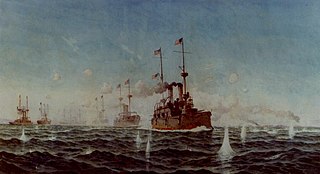
The Battle of Manila Bay, also known as the Battle of Cavite, took place on 1 May 1898, during the Spanish–American War. The American Asiatic Squadron under Commodore George Dewey engaged and destroyed the Spanish Pacific Squadron under Contraalmirante Patricio Montojo. The battle took place in Manila Bay in the Philippines, and was the first major engagement of the Spanish–American War. The battle was one of the most decisive naval battles in history and marked the end of the Spanish colonial period in Philippine history.

SS Saint Paul was a trans-Atlantic ocean liner named for the capital of Minnesota.

The Puerto Rico campaign was the American military sea and land operation on the island of Puerto Rico during the Spanish–American War. The offensive began on May 12, 1898, when the United States Navy attacked the capital, San Juan. Though the damage inflicted on the city was minimal, the Americans were able to establish a blockade in the city's harbor, San Juan Bay. On June 22, the cruiser Isabel II and the destroyer Terror delivered a Spanish counterattack, but were unable to break the blockade and Terror was damaged.

USS Yankee was originally El Norte, a steamer launched 14 June 1892 and delivered 15 August 1892 at Newport News, Virginia, by the Newport News Shipbuilding & Drydock Co. for the Southern Pacific Railroad's Morgan Line. The ship was acquired by the United States Navy from the Southern Pacific Company on 6 April 1898. The ship was renamed and commissioned at New York on 14 April 1898, Commander Willard H. Brownson in command.
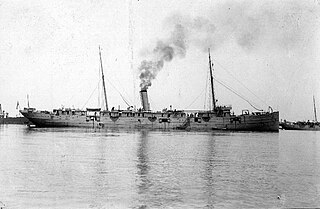
The first USS Yosemite was an auxiliary cruiser of the United States Navy. Built as El Sud in 1892 by Newport News Shipbuilding and Dry Dock Company, in Newport News, Virginia for the Southern Pacific Railroad's Morgan Line. The Navy acquired El Sud on 6 April 1898, at the beginning of the Spanish–American War and renamed her Yosemite. It commissioned her on 13 April 1898 under Commander William H. Emory.
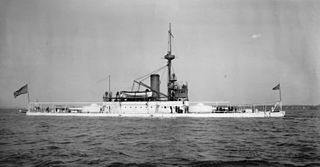
USS Terror —the totally rebuilt version of the earlier monitor Agamenticus, which had shared the Terror's name—was an iron-hulled, twin-screw, double-turreted monitor of the Amphitrite class; on June 23, 1874 by order of President Ulysses S. Grant's Secretary of Navy George M. Robeson in response to the Virginius Incident laid down at Philadelphia contracted by William Cramp & Sons. Her construction progressed over the next three years until suspended in 1877. Work was resumed six years later, and the monitor was launched on 24 March 1883.

The timeline of events of the Spanish–American War covers major events leading up to, during, and concluding the Spanish–American War, a ten-week conflict in 1898 between Spain and the United States of America.
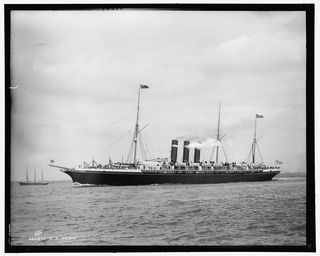
City of Paris, was a British-built passenger liner of the Inman Line that held the Blue Riband as the fastest ship on the north Atlantic route from 1889 to 1891 and again from 1892 to 1893. A sister ship of the City of New York and a rival of the White Star Line Teutonic and Majestic, she proved to be the quickest of the pre-Campania twin-screw express liners. In 1893, she was renamed Paris and transferred to US registry when the Inman Line was merged into the American Line. She and her sister were paired with the new American built St Louis and St Paul to form one of the premier Atlantic services. Paris served the US Navy as the auxiliary cruiser USS Yale during the Spanish–American War and is remembered for slipping into the harbor at San Juan, Puerto Rico, under the Spanish guns of Morro Castle. After Paris returned to commercial service, she was seriously damaged in 1899 when she grounded on The Manacles off the British coast. Rebuilt and renamed Philadelphia, she sailed for the American Line until requisitioned again during World War I as the transport Harrisburg. After the war, she continued with the American Line until 1920 and was scrapped in 1923.
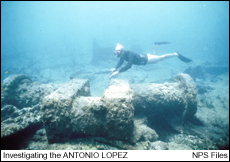
The Antonio López was a historic vessel of the Spanish merchant marine. When built in 1881–82, she was the first Spanish-built steel merchant vessel with a complete electrical lighting system. She was also one of the most important Spanish blockade-runners during the American blockade of (then-Spanish) Puerto Rico during the Spanish–American War, its crew delivering a supply of military materials critical to the island's defense after the ship was grounded in June 1898 under fire from the Americans. The shipwreck is the only known Spanish wreck in American waters from the conflict. Its wreck site, in 1,700 feet (520 m) of water off Dorado, Puerto Rico, was designated a National Historic Landmark in 1997.
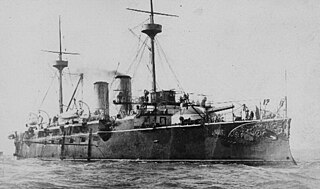
Vizcaya was an Infanta Maria Teresa-class armored cruiser of the Spanish Navy that fought at the Battle of Santiago de Cuba during the Spanish–American War.
Plutón was a Furor-class destroyer of the Spanish Navy that fought at the Battle of Santiago de Cuba during the Spanish–American War.

Terror was a Furor-class destroyer of the Spanish Navy that fought at San Juan, Puerto Rico during the Spanish–American War. Constructed in the United Kingdom, the ship entered service in 1896 and was significantly damaged at the Second Battle of San Juan in 1898. In 1920, the destroyer was converted to a minelayer and discarded in 1924.

Isabel II was a Velasco-class unprotected cruiser of the Spanish Navy, named after Queen Isabella II. The ship fought at San Juan, Puerto Rico, during the Spanish–American War.

General Concha was a General Concha-class Cañonero (gunboat) or more technically "Third Class non-armored Cruiser" of the Spanish Navy which fought at San Juan, Puerto Rico, during the Spanish–American War.

The Flying Squadron was a United States Navy force that operated in the Atlantic Ocean, the Gulf of Mexico and the Spanish West Indies during the first half of the Spanish–American War. The squadron included many of America's most modern warships which engaged the Spanish in a blockade of Cuba.

The Second Battle of San Juan occurred on 22 June 1898 when two Spanish vessels tried to break the American blockade off San Juan.

The Bombardment of San Juan, or the First Battle of San Juan, on 12 May 1898 was an engagement between United States Navy warships and the Spanish fortifications of San Juan, Puerto Rico. It was the first major action of the Puerto Rican Campaign during the Spanish–American War.

The action of 13 June 1898 was a minor naval engagement of the Spanish–American War fought near Cienfuegos, Cuba, between the American auxiliary cruiser USS Yankee under Commander Willard Herbert Brownson and the Spanish gunboat Diego Velázquez under Teniente de Navío de 1ª clase Juan de Carranza y Reguera, which had exited the port to inspect a suspicious steamer which proved to be Yankee. Diego Velázquez, markedly inferior to Yankee in armament, managed to return to Cienfuegos, where it was joined by the small gunboats Lince and Cometa. After the appearance of the latters, Yankee decided to withdraw.

Ramón Acha Caamaño was a brigadier general in the Spanish Army. As Captain in charge of the Spanish Artillery in San Juan, he defended Puerto Rico against U.S. attack during the Spanish–American War.


















